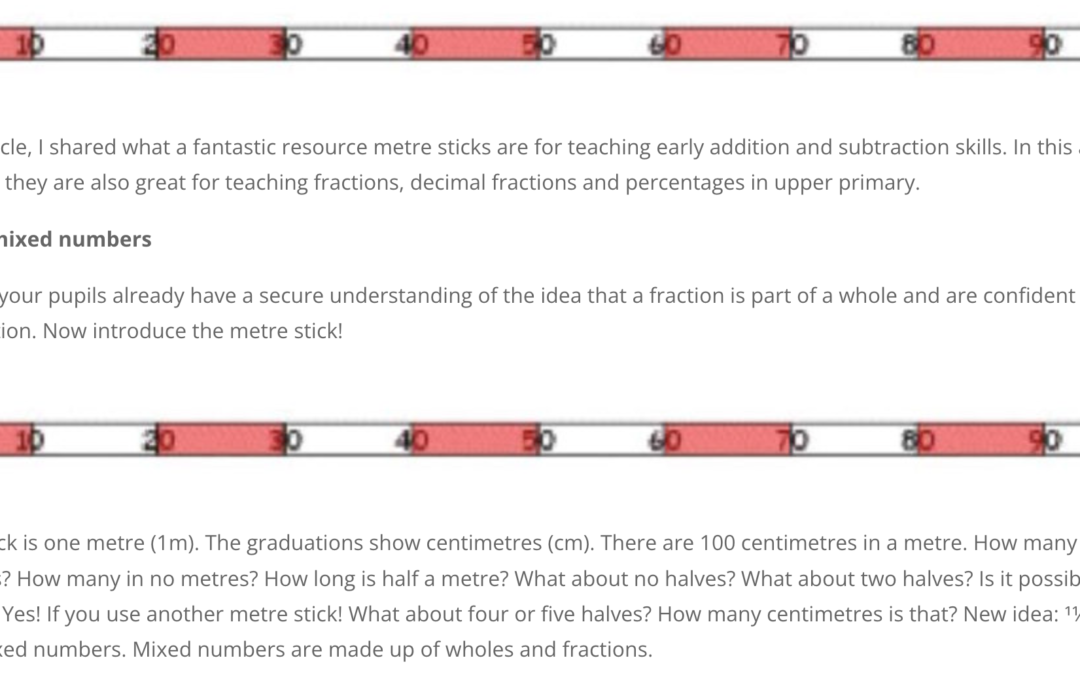(first published in the SMC Journal Issue 48)

In my last article, I shared what a fantastic resource metre sticks are for teaching early addition and subtraction skills. In this article I will highlight how they are also great for teaching fractions, decimal fractions and percentages in upper primary.
Halves and mixed numbers
Let’s assume your pupils already have a secure understanding of the idea that a fraction is part of a whole and are confident in using fraction notation. Now introduce the metre stick!

The whole stick is one metre (1m). The graduations show centimetres (cm). There are 100 centimetres in a metre. How many centimetres in two metres? How many in no metres? How long is half a metre? What about no halves? What about two halves? Is it possible to have three halves? Yes! If you use another metre stick! What about four or five halves? How many centimetres is that? New idea: 11⁄2m and 21⁄2m are called mixed numbers. Mixed numbers are made up of wholes and fractions.
Quarter metres & improper fractions
Once the children have grasped the idea of halves we can then move on to quarters. How can we divide the metre stick into four equal pieces? Where would 1⁄4 of a metre be? What about 0, 2, 3, 4 quarters of a metre?
Can you get five quarters? Yes! This would be 1 1⁄4 metres or 125cm. How about six quarter metres? We can write 5, 6 or 7 over 4. These are called improper fractions.
Decimal fractions and equivalences
To understand common and improper fractions well, children need to understand their relationship with decimal fractions. First explore tenths. How can we split the metre stick into ten equal parts? What fraction of the metre stick is each part? Point out that each coloured section is one tenth of the metre stick, or 10cm. How many centimetres in 4/10, 7/10, 9/10 of a metre?

We can write one tenth like this: 0∙1. We say ‘zero point one’. The zero shows there are no whole metres and the one shows we have one coloured section, or one tenth. How would you write two tenths as a decimal? How would you read that?

Where is 1⁄2m? How many tenths is that? How could we write 1⁄2m as a decimal fraction? How would you read it?
Ten tenths is one whole metre. Can you get 11 tenths? Yes! You need another metre stick! One whole metre and one tenth of a metre can be written as 1∙1. What do you think 1∙2 means? How about 1.7 etc.?
How could you divide the metre stick into five equal pieces? [see ‘Chopping up a Metre Stick’ for a more in depth practical investigation] What fraction of the metre stick is each piece? One fifth of a metre = 20cm = 0.2m. What would two fifths of a metre be? How about three fifths, four fifths, five fifths? Which is bigger, one fifth or one tenth? How do you know? We say 1 fifth is equivalent to 2 tenths. What other equivalences can you find? (2 fifths = 4 tenths, 3 fifths = 6 tenths etc.)
Add an element of challenge by introducing twentieths. Which is bigger: one twentieth or one fifth? How many times bigger / smaller is a fifth compared to a twentieth / tenth? What other equivalences can you find between fifths, tenths and twentieths?
Percentages
If one hundred percent (100%) equals one whole how would you show 1% on your metre stick? Suddenly all the easy equivalences between fractions, decimal fractions and percentages are open to us:
One quarter of a metre = 25cm = 25%. How would you write two quarters, three quarters as percentages?
1 fifth of a metre = 20cm =20%. How would you write two fifths, three fifths, four fifths as percentages?
1 twentieth of a metre = 5cm = 5%. Challenge the children to find all other equivalences from two twentieths = 10% up to nineteen twentieths = 95%
Extend these ideas further to include twenty-fifths and fiftieths.
Factor rainbows
Finally: if you have never used factor rainbows you have been missing out on something wonderful. [see ‘Multiplication Rectangles and Factor Rainbows’ for a more. In depth investigation of these] Here is the factor rainbow for 100.

Something to puzzle over: What do these numbers have to do with the denominators of the fractions that can be easily converted to percentages? Aha!
Author:
Rob Porteous
Deputy Head, Learning and Teaching, George Watson’s College, Edinburgh
Email: r.porteous@gwc.org.uk
Creator of the Maths Investigations Website.
